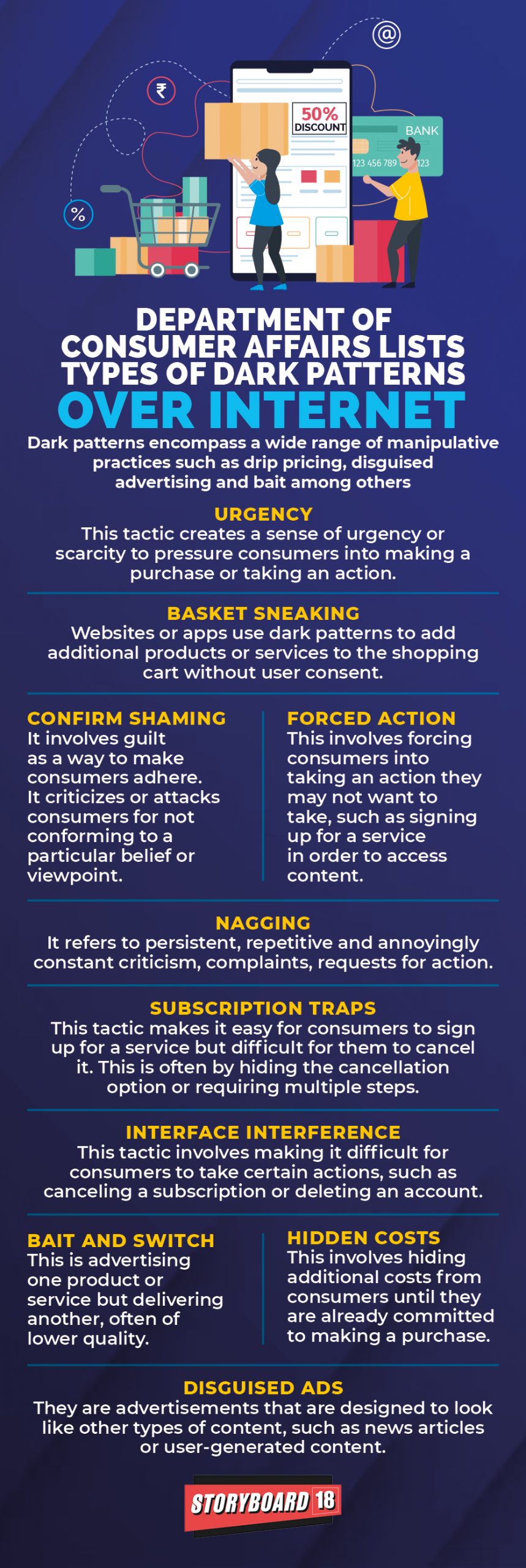The Department of Consumer Affairs (DoCA) along with the Advertising Standards Council of India (ASCI) hosted an interactive consultation with stakeholders on “Dark Patterns” in Mumbai on Tuesday. The session was chaired by Rohit Kumar Singh, secretary, Department of Consumer Affairs.
Dark patterns encompass a wide range of manipulative practices such as drip pricing, disguised advertising, bait and click, choice
manipulation, false urgency, and privacy concerns. This could mean consumers are being forced to buy products online, taking personal
data without consent, shaming users for not purchasing a subscription, etc. “We need to first identify the dark pattern and then educate both consumers and the sellers. Often, over the internet, users are being manipulated through dark patterns. It’s happening on almost every website. Many times sellers are not even aware that certain tactics are being used to sell their products. We have to create a self-regulatory framework with ASCI, and a couple of law firms and industry stakeholders have agreed to follow it,” says Rohit Kumar Singh, secretary, Department of Consumer Affairs.

On the sidelines of a press conference, DoCA and ASCI also hosted an interactive consultation on “Dark Patterns” which was attended by executives from nearly three dozen platforms and industry heads. They include Flipkart, Zomato, Amazon, Meta, Google, MakeMyTrip, Yatra,
Snapdeal, Uber, Ola, BigBasket, Meesho, Pharmeasy, Tata 1mg, and Shiprocket. The meeting also witnessed the presence of Retailers
Association of India, NASSCOM, ONDC, and Khaitan & Co.
During the interaction with the stakeholders, the Consumer Affairs Ministry’s Secretary highlighted that digital, which is a crucial part of the consumer’s everyday life, certain aspects of UI/UX design and online choice architecture guide consumer choices. However, they become a cause of concern when they are manipulated to a level which proves detrimental to the consumers. In such a situation, equipping users with tools and resources like browser extensions, apps, or plugins that detect and block dark patterns, or platforms providing clearer and more accessible settings and privacy options could prevent the severe implications of dark patterns.
There have been cases where brands have erred in the past with their misleading ads and deceptive marketing tactics much before ASCI came up with. How would ASCI keep track of this? Would the upcoming guidelines apply to them too, along with the ones who are presently
erring? “It is about ads that are current, which consumers are able to see today and make a decision regarding how to engage, how to buy, etc. It will be about ads that we are seeing now in the market,” Manisha Kapoor, chief executive officer and secretary General, ASCI clarifies to Storyboard18.
About 80 percent of the ads are taken up by the self-regulatory body itself. About 20 percent of them come in as external complaints where either a consumer is complaining or an industry may complain against someone else. Sometimes, complaints get passed on by the government too.
Kapoor explains, “There is a huge effort on suo moto kind of surveillance monitoring, and we are deploying AI-based systems. Can we
track 100 percent? No, we can’t. But, we will prioritize certain sectors, certain areas where we believe the consumer harm will be
high.”
But the key thing is, as Kapoor puts it, how do they build awareness and make citizens vigilant, where consumers become the eyes and ears of understanding what ASCI can or cannot do? “It is an ongoing effort and it is not going to happen overnight,” she adds.
Speaking about how eDaakhil (an online portal launched in 2020 by The National Consumer Disputes Redressal Commission to facilitate online and offline complaints with respect to the Consumer Protection Act) will help keep dark patterns at bay, Kapoor mentions that eDaakhil is a mechanism to help consumers file court cases easily. However, that stands as the last resort.
The interactive consultation with the stakeholders and the industry was received with unanimous approval, where they agreed that there was a need to develop a self-regulatory framework where all sectors would be represented. Guidelines focusing on dark patterns will be released within a span of two months.
